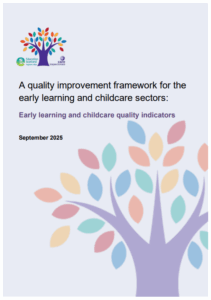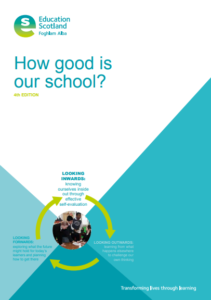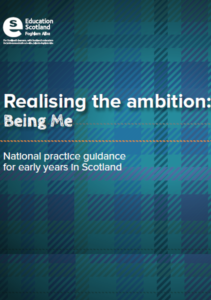Vision, Values & Aims
– Reflecting on Practice
Leadership and Management of Staff and Resources p4 – Vision values and Aims
We promote, sustain and are highly committed to a shared vision that reflects the highest possible standards for children, families, partners and the wider community. Children and families are actively included in the design and review of our vision, values and aims. These reflect the high aspirations of our children and families. This ensures that any planned developments or improvements take due account of children’s rights, interests, curiosities, needs and preferences. Leaders create conditions where all people feel confident to initiate well-informed change and share responsibility for the process. This helps us know what is important when meeting the needs of children and families. Effective communication ensures a clear view of our vision, values and aims so that the wider staff team, children and families are included in achieving them. Our values are embedded in the everyday life of the setting and inform our practice. Leadership is clearly founded on principles of high-quality care and learning, active engagement with children and their families and a quality culture.”
p8
How effectively do we engage others to develop a shared vision and purpose for our setting?
How well do our vision, values and aims inform our daily practice?
What impact do our vision, values and aims have on improving the quality of the early learning and childcare (ELC) we provide?
QI 1.3 p24 – Level 5 Illustration
Developing a shared vision, values and aims relevant to the school and its community We are committed to ensuring that we achieve the highest possible standards and success for all learners. All staff show commitment to shared educational values and professional standards. Senior leaders provide strong leadership which has enabled our school and wider community to develop, promote and sustain an aspirational vision which underpins our continuous improvement. Our vision evolves through ongoing reflection and debate across the school and community. As a result of this active collaboration, the school and community have ownership of the vision, values and aims. These are shaped by our clear understanding of the social, economic and cultural context in which children, young people and their families live alongside our awareness of current policy and practice. Through effective leadership at all levels, our school community works together to turn the shared vision into a sustainable reality.
p25 – Features of Highly Effective Practice
Pupils, parents, partners and staff are all involved in the creation and ongoing review of the vision, aims and values of the school.
All staff have a very clear understanding of the social, economic and cultural context of the local community of current educational policy. They use this knowledge well to shape the vision for the school.
The vision of the school is ambitious and focuses on improvements in outcomes for all.
Learners are supported to understand the vision aims and values through the four contexts for learning.
Leaders at all levels motivate and inspire others to sustain collective commitment to the shared vision through daily actions.
All teaching staff regularly reflect on, and show commitment to, the shared values as embedded in the GTCS standards
Challenge Questions
To what extent does our school community have ownership of our vision, aims and values?
What range of data and information do we utilise to understand the social, economic and cultural context of the local community?
How effective are our processes for involving the whole school community in the ongoing review of our vision, aims and values?
What strategies do we employ to translate our vision, values and aims into daily practice within our school? How effective are these?
How well do we use our vision, aims and values when making decisions about future improvement priorities?
5.4 p59
Parental involvement includes activities such as parental representation in the development of the vision, policies or improvement plans of the setting and other key decisions
p82
Quality settings have… a clear, shared vision Effective settings have a clear shared vision for what they would like their provision to be and what they want for the children in their care. The vision should be based on the unique needs of your children and families in your setting. Developing a vision that is co-created by us with children and families means that everyone is working together for the best interests of the children. It is important to refresh the vision from time to time to ensure that it remains relevant to the community you work within.
p6 Section 4 – School culture values and ethos
The promotion of positive relationships through whole school culture, ethos and values, is fundamental to raising attainment and improving behaviour. Schools that promote positive relationships across the classroom, playground and wider school community have a nurturing ethos and culture that is essential for creating the right environment for effective learning, health and wellbeing. Children and young people are more likely to develop self-confidence, resilience and positive views about themselves where open and respectful relationships exist between adults and other children and young people.
p7
Scottish Border’s ambition for an inclusive ethos and practice across all its learning establishments is firmly rooted in everyone’s contribution being valued and everyone’s voice being heard. Our drive to develop schools with a positive, nurturing ethos is aligned with our drive to raise attainment. The two are inextricably linked. In developing a Nurturing authority and positive ethos we expect Scottish Borders schools to raise their expectations of themselves and their learners; build on current success in attainment and enable greater levels of achievement. As a result, our schools will see higher levels of engagement, and lower levels of exclusion and disruptive behaviour. Please refer to SBC’s Nurturing Approaches document for detailed information and guidance.
6. Essential Components of a Nurturing School or Setting
The Nurture Principles should be embedded and communicated every day in schools and settings.
Using the self-evaluation toolkits in the “Applying Nurture as a Whole School Approach” document will support this..” This can be achieved by agreeing on a ..” Vision and Aims statements around Nurture (at cluster, school/setting, classroom/playroom level). Set firm boundaries and expectations around high standards of behaviour – creating a whole school/setting charter and displaying these in corridors, classrooms, playrooms etc. Don’t be afraid to provide firm, but fair boundaries and consequences, or “authoritative limit setting” but always go for a restorative approach and avoid shaming and punishment- this is really counter-productive to your overall goals….





